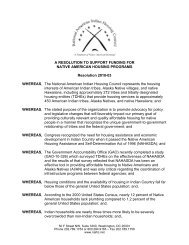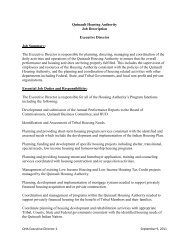CASE STUDY - National American Indian Housing Council
CASE STUDY - National American Indian Housing Council
CASE STUDY - National American Indian Housing Council
You also want an ePaper? Increase the reach of your titles
YUMPU automatically turns print PDFs into web optimized ePapers that Google loves.
IntroductionThe condition of housing continues to be detrimental for Native <strong>American</strong>s andAlaska Natives. Functioning with under-developed economies and, in some cases,no developed economies at all, have forced tribes and Alaskan communities tocontinue to seek funding. Current funding for <strong>Indian</strong> housing is insufficient toaddress critical housing shortages. These shortages constitute a commondenominator for all Native communities. The complexities of land status and tribalsovereignty continue to make leveraging of federal, state and private sector funds ahardship.The unique nature of <strong>Indian</strong> tribes, cultures, and economies, the complexities ofland ownership and governmental status, and the relationship between the variousfederal, state and tribal agencies affect the design, administration and success of tribalprograms. Each environment is different and it is important to understand that each isa Nation within a Nation and each has a government-to-government relationship withthe United States.It is within these contexts, and under current legislation, that tribes and AlaskaNatives strive to develop sufficient housing programs and provide homes for theirpeople.BACKGROUNDIn the mid-1990s, the federal government assessed Native <strong>American</strong> housingneeds and reassessed existing housing programs. On October 26, 1996, PresidentClinton signed the Native <strong>American</strong> <strong>Housing</strong> Assistance and Self-Determination Actof 1996 (NAHASDA) into law. NAHASDA replaced previous legislation relating to<strong>Indian</strong> housing assistance and balanced the government’s trust and treatyresponsibilities with the need for tribal control of <strong>Indian</strong> communities. This newlegislation replaced several separate programs of assistance instituted under previous<strong>Indian</strong> housing legislation, known as the United States <strong>Housing</strong> Act of 1937, with asingle block grant. The three main variables used in determining the amount of theblock grant each tribe receives are• Population• <strong>Housing</strong> need• Current assisted stockIn order to draw down funds for the block grant, tribes are required to complete afive-year plan called the <strong>Indian</strong> <strong>Housing</strong> Plan (IHP). The Office of Native <strong>American</strong>Programs (ONAP) is required to review these plans, provide technical assistance to tribeswhen necessary, and review tribal compliance with NAHASDA.v




